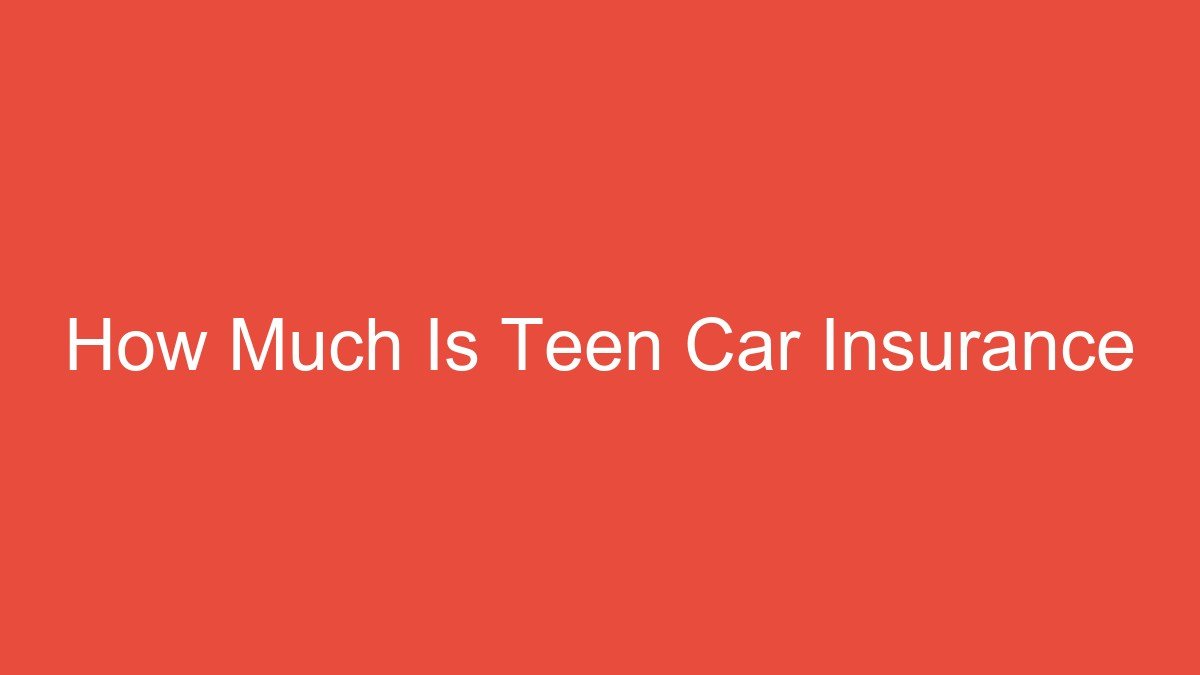
Contents
- Navigating the Roads: How Much Is Teen Car Insurance (And How to Save!)
- The Big Question: How Much Is Teen Car Insurance?
- Why Is Teen Car Insurance So Expensive? Understanding the “Why”
- Step-by-Step: Getting Your Teen Insured
- Smart Strategies to Save Money on Teen Car Insurance
- Common Mistakes to Avoid When Insuring a Teen
- Conclusion: Driving Towards Affordability
- FAQ
- Related Articles
Getting a driver’s license is a monumental rite of passage for teenagers – a symbol of freedom, independence, and new adventures. For parents, it’s often a mix of excitement, pride, and a touch of anxiety… especially when thinking about teen car insurance costs. Let’s be real: insuring a young driver can feel like navigating a complex maze with dollar signs at every turn.
But don’t fret! This detailed guide is here to demystify how much teen car insurance typically costs, why it’s so expensive, and most importantly, how to find the best rates for your young driver without sacrificing crucial coverage. We’ll walk you through the process, offer smart tips, and highlight common pitfalls to avoid.
The Big Question: How Much Is Teen Car Insurance?
Let’s get straight to the point. There’s no single, universal answer, as the cost varies wildly based on many factors. However, we can give you a realistic range.
🛒 Recommended Product
Expect to pay significantly more to insure a teen driver than an experienced adult. Typically, adding a teen to an existing family policy or purchasing a separate policy for a young driver can increase your annual premium by anywhere from $2,000 to $6,000+ per year, depending on the insurer, location, vehicle, and various other factors. For a teen getting their own policy, the cost could be even higher.
This isn’t a fixed price, but a general estimate to help you prepare. The good news is, there are many strategies to help bring these costs down!
Why Is Teen Car Insurance So Expensive? Understanding the “Why”
It’s natural to wonder why these rates are so high. Insurance companies are all about risk assessment, and unfortunately, statistics paint a clear picture for new, young drivers:
- Lack of Experience: This is the primary factor. Teens simply haven’t spent as much time behind the wheel as adults, leading to less developed judgment and reaction times.
- Higher Accident Rates: Data consistently shows that drivers aged 16-19 have the highest crash rates of any age group, especially during the first few years of driving.
- Riskier Driving Behavior: Teens are statistically more prone to distracted driving (texting, passengers), speeding, and driving under the influence (though this decreases with education and awareness).
- Vehicle Type: If your teen drives a newer, more expensive, or high-performance vehicle, the cost of repairs or replacement after an accident will be higher, leading to higher premiums.
- Location: Living in an urban area with more traffic and higher crime rates will generally result in higher premiums than in a rural area.
- Coverage Levels: The more coverage you opt for (e.g., comprehensive, collision, higher liability limits), the higher the premium.
- Gender (sometimes): While less of a factor than in the past, some insurers still consider gender, with young males statistically having higher rates than young females due to higher average claim costs.
Step-by-Step: Getting Your Teen Insured
Don’t let the potential costs intimidate you. Insuring your teen is a necessary and manageable process. Here’s a practical guide:
Step 1: Get That License (or Permit)!
Before you can insure them, your teen needs to be legally learning to drive or have their full license. Most insurers require you to add a teen to your policy once they obtain their learner’s permit, even if they aren’t fully licensed yet. This ensures they are covered during supervised practice.
Step 2: Decide on the Vehicle
This is a critical decision for your insurance costs.
* Existing Family Car: Will your teen primarily drive an existing car in the household? If so, you’ll simply add them as a driver to that vehicle’s policy.
* New Car for Your Teen: If you’re buying a separate car, aim for something safe, reliable, and older (but well-maintained). Vehicles with high safety ratings, lower horsepower, and less market value are always cheaper to insure. Avoid sports cars or luxury vehicles at all costs.
Step 3: Talk to Your Current Insurance Provider
This is often the easiest and most cost-effective first step. Contact your current insurer to discuss adding your teen.
* They can provide specific quotes based on your existing policies and offer any available multi-driver or good student discounts.
* Ask if it’s better to add them as a primary driver to one of your existing vehicles or assign them to their own vehicle if applicable.
🛒 Recommended Product
Step 4: Shop Around (Get Multiple Quotes!)
Do not settle for the first offer, even from your current insurer. Insurance rates vary significantly between companies.
* Get quotes from at least 3-5 different insurance providers.
* Utilize online comparison tools, but also consider contacting independent insurance agents who can shop multiple carriers for you.
* Be prepared to provide details like your teen’s age, gender, GPA (for discounts), vehicle make/model/year, and your desired coverage levels.
Step 5: Compare Policies Carefully
Don’t just look at the price! Ensure you’re comparing apples to apples.
* Coverage Limits: Are the bodily injury, property damage, and other liability limits the same across quotes?
* Deductibles: What is the deductible for comprehensive and collision coverage? A lower deductible means higher premiums.
* Included Benefits: Are there any unique benefits or add-ons from one policy that justify a slightly higher cost?
Step 6: Choose and Enroll
Once you’ve found the best balance of cost and coverage, complete the application and make your first payment. Ensure you understand all the terms and conditions.
Smart Strategies to Save Money on Teen Car Insurance
While teen insurance is expensive, there are many proactive steps you can take to mitigate the cost.
- Good Student Discount: Many insurers offer a significant discount (often 10-25%) if your teen maintains a B average (3.0 GPA) or higher. Keep those report cards handy!
- Driver’s Education Discount: Completing an approved defensive driving course or certified driver’s education program can also qualify your teen for a discount. This isn’t just about saving money; it makes them a safer driver.
- Telematics / Usage-Based Insurance: Consider programs that use a device (or smartphone app) to monitor your teen’s driving habits (speed, braking, mileage). Safe driving behavior can lead to considerable discounts.
- Choose the Right Car: As mentioned, a safe, reliable, mid-range sedan or SUV with strong safety ratings is ideal. Avoid sports cars, luxury vehicles, or highly modified cars. Older, lower-value cars also mean lower comprehensive and collision costs.
- Raise Your Deductible: If you have an emergency fund, increasing your collision and comprehensive deductibles (e.g., from $500 to $1,000) can lower your premium. Just be sure you can comfortably afford the deductible in case of a claim.
- Bundle Policies: If you haven’t already, bundle your home/renters and auto insurance with the same provider. This almost always results in a multi-policy discount.
- Multi-Car Discount: If you have multiple vehicles on your policy, adding another (even for a teen) can sometimes trigger a multi-car discount for the whole household.
- Maintain a Clean Driving Record: This is paramount. Every ticket, fender bender, or accident will significantly increase your teen’s rates for years to come. Emphasize responsible driving from day one.
- Consider an Older Vehicle (without full coverage): If your teen is driving an older, low-value car, you might consider dropping collision and comprehensive coverage to save money. However, ensure you’re comfortable replacing the car out-of-pocket if it’s totaled. Liability coverage is always legally required.
- Parking and Security Discounts: Some insurers offer discounts for vehicles with anti-theft devices or those parked in a garage.
Common Mistakes to Avoid When Insuring a Teen
Steer clear of these common pitfalls that can cost you more in the long run:
- Not Shopping Around: As tempting as it is to stick with your current insurer, failing to get multiple quotes is one of the biggest mistakes you can make. You could be leaving hundreds or even thousands of dollars on the table.
- Omitting Your Teen Driver: NEVER hide a teen driver from your insurance policy. This is considered insurance fraud. If your teen gets into an accident and isn’t listed, your claim could be denied, leaving you personally responsible for all damages and potentially facing legal consequences.
- Buying the “Cool” Car: A sporty car might look great, but it will come with a much higher insurance premium for a teen driver. Prioritize safety and affordability.
- Skimping on Liability Coverage: While you might want to save money on physical damage coverage for an older car, do not skimp on liability limits. In today’s world, state minimums are often woefully inadequate. An at-fault accident with injuries could easily exceed minimum limits, putting your family’s assets at risk.
- Ignoring Available Discounts: Make sure you’re asking about and applying for every discount your teen (and your policy) qualifies for.
- Not Reviewing Your Policy Annually: Insurance rates and your family’s needs change. Review your policy with your agent every year to ensure you still have the best coverage and are getting all possible discounts.
Conclusion: Driving Towards Affordability
Insuring a teen driver is undoubtedly an added expense, but it’s a necessary one that contributes to their safety and your peace of mind. By understanding the factors that influence cost, following a smart step-by-step process, and implementing money-saving strategies, you can make this transition much more manageable.
Prioritize safety, teach responsible driving habits, and be diligent in your search for the best insurance rates. With a little research and proactive effort, you can help your teen hit the road confidently without breaking the bank.
🛒 Recommended Product
Start getting quotes today and empower your teen with the freedom of the open road – responsibly and affordably!
FAQ
Q. Why is teen car insurance so expensive?
A. Teen drivers are statistically more likely to be involved in accidents due to their inexperience, higher risk-taking behavior, and less developed hazard perception. Insurance companies price policies based on risk, and teens represent a higher risk pool, leading to significantly higher premiums.
Q. How much can I expect to pay for teen car insurance?
A. The cost varies greatly depending on factors like your location, the specific insurance company, the type of car, coverage limits, and the teen’s driving record. However, adding a teen to an existing policy can often increase premiums by 50% to 100% or even more. A separate policy for a teen can easily run into thousands of dollars annually.
Q. What are some ways to reduce the cost of teen car insurance?
A. Several strategies can help lower costs: enrolling in a good student discount (typically for a B average or higher), taking defensive driving courses, choosing a safe and used car for the teen, opting for higher deductibles, bundling multiple policies with one insurer, and utilizing telematics (usage-based insurance) programs.
Q. When should I add my teen to my car insurance policy?
A. Generally, you should inform your insurer and add your teen as soon as they get their learner’s permit, especially if they will be driving any of your vehicles. It is crucial to add them once they receive their provisional or full driver’s license, as they are then legally authorized to drive unsupervised.
Q. Does the type of car a teen drives affect insurance costs?
A. Absolutely. Insurers consider the car’s safety ratings, repair costs, likelihood of theft, and engine size. Safer, older, and less powerful vehicles (e.g., sedans, minivans) typically have lower premiums than new, high-performance, or luxury cars, which are more expensive to repair and more attractive to thieves.
Q. Are there any discounts specifically for teen drivers?
A. Yes, the most common is the “good student discount,” often available for teens maintaining a B average (3.0 GPA) or higher. Some insurers also offer discounts for completing approved driver education courses or for participation in telematics programs that monitor driving habits like safe speed and smooth braking.
Q. Does a teen’s gender impact their insurance rates?
A. Historically, male teen drivers often paid more than female teen drivers due to higher accident rates among young males. However, several states have banned the use of gender as a rating factor for car insurance, so its impact now varies by state and insurer. In states where it’s still allowed, young males might still see higher rates.
Related Articles
How Much Does a Tesla Cybertruck Cost
How Much Does a Tesla Cybertruck Cost? Your Ultimate Guide to Pricing & Purchase The Tesla Cybertruck has captured imaginations with its futuristi…
How Much Is a Tesla
How Much Is a Tesla? Unpacking the Cost of Your Dream EV Dreaming of driving a Tesla? You’re not alone! These innovative electric vehicles have …
Affiliate Disclosure: As an Amazon Associate, I earn from qualifying purchases made through links on this site.















